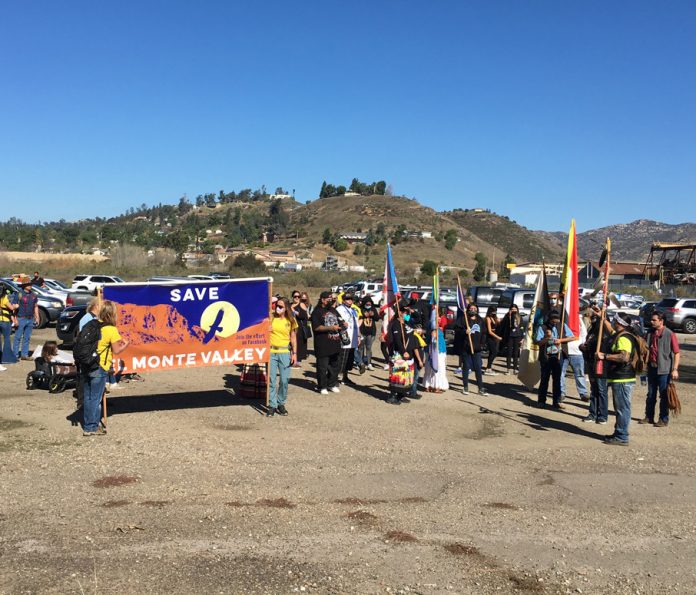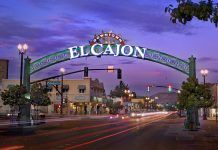A group of around 100 local Lakeside, East County and tribal member activists walked two miles near state Route 67 into the heart of El Monte Valley to show support of the County acquisition of 104 acres of land in the valley to show that Lakeside and East County loves the El Monte Valley. The County is considering purchasing 98 acres from the Helix Water District as part of its Sustainable Environments/Thriving Initiative on Feb. 10.
Adjacent to this land, the El Monte Sand Mining Project has been postponed for 1.5 years. The sand miners, Horizon Hill El Monte Investors, LLC, have began the process and intend on mining sand for the next 20 years.
Local activist and Barona Band of Mission Indians tribal member Bobby Wallace said he has been dealing with numerous plans that involve El Monte Valley for more than 20 years. He said it has been small community efforts to move things along to where the valley stands today. He supports the County’s acquisition.
Wallace said the walk was a positive event with tribal members from Barona, Viejas, Sycuan, La Posta, Manzanita, Campo, and other tribes.
“We had a great line of people. It was phenomenal,” he said. “We had blue and green flags on. Green for the land, blue for the water on our arms. Every step that we took that day was a prayer and as far as you could see down the trail was a ceremony.”
Wallace said anyone walking through the valley touches a piece of the Kumeyaay’s presence in the area since the beginning.
“If the same piece of sand that hits your foot that one of my ancestors touched 7,000 years ago, maybe that piece of sand was way up in Santa Isabel or maybe halfway down the river through the mountains, it is just amazing. Guaranteed, somebody’s foot hit a piece of sand that one of our ancestors had touched before,” he said.
Wallace said at the end of the walk, they prayed for tribal leaders and the governmental officials that must make these hard decisions.
“Someone is always going to want to do something here, whether it be sand mining or something radical,” he said. “Go pummel our ancestors, smashing all the bones so they do not have to report them, and all the artifacts. I know personally that there is a lot out there.”
Wallace said the county has the first right for refusal in purchasing this land and if they do not, it could be up for grabs for sand miners and people that ultimately want to destroy the valley.
“It will upset the balance of the valley,” he said.
Wallace said the valley is rich with cultural resources as the San Diego River was the lifeline for the Kumeyaay people.
“We were hunters and gatherers and traveled up and down the river,” he said. “They are just going to tear it up. It is nothing against anyone personally, but this is the home of Lakeside.”
Wallace said that the valley is known as a habitat for valley fever, and that is a concern to everyone involved in opposing more sand mining in the region, along with the density of trucks traveling daily with tons of sand.
“Helix Water District agreed to supply water for the project when water is such a precious resource right now,” he said. “They are going to use it to try and stop the dust from flying. We have valley fever. We get Santa Anas. We know it blows through that valley hard and it goes right through Lakeside and El Capitan High School. Everybody is going to get whiffs of something. It is just inevitable.”
Wallace said there is huge traffic travelling state Route 57 heading north and when the trucks come out of the valley, they will have to travel up El Monte Road to highway 67 or head the opposite way towards Lake Jennings.
“How are they going to do that? Are they going to pay for all the roadwork or is the County going to have to flip the bill for that? If the County flips the bill, why don’t they just buy the piece of land,” he said.
Brooke Baines lives in Alpine and is a descendant of the Manzanita Band of the Kumeyaay Nation. Her father and grandmother are both enrolled tribal members.
“I am 19 years old, so I am new to all of this,” she said. “I do not know the history like many others do. But my spirit is connected with Mother Earth and the land. We have already desecrated enough areas. You do not have to keep undoing all the land. If you do, there is no going backwards.”
Baines said the walk was about protecting the land and bringing awareness to the un-desecrated parts of San Diego County, especially, this section of the San Diego River.
“All of the San Diego River is sacred to the Kumeyaay people because it was the path that we followed to go up to the mountains. It was the trail we used to travel. It was the main trail because there was water all the way,” she said. “In my heart and spirit, I was out there to get a feel of the area, the land, the energy and make people understand that there are people that do care about this land. We do not want to see it desecrated and built into sand mines and construction. I was there to pray for the land that the desecration will stop.”














